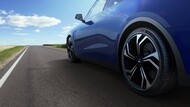
No. As long as load capacity restriction are observed, all Michelin tirelines will function properly on both Internal Combustion Engine (ICE) vehicles and EVs.
If in cases such as winter tires, a lower speed rating than listed on the vehicle placard are installed for use in winter conditions, the speed capability of the vehicle is reduced to the speed rating of the winter tires.. (2021 MAST Fitment Guide, “Winter Tires”, page 22)
